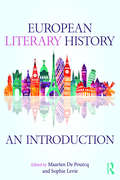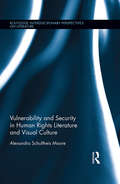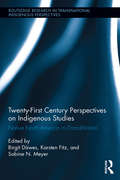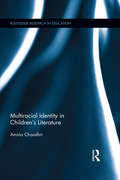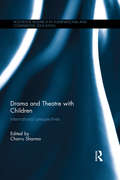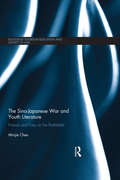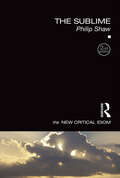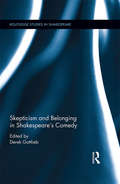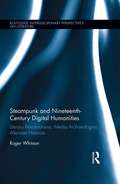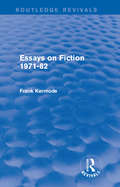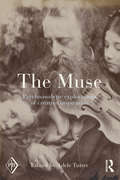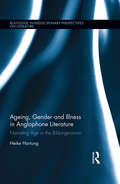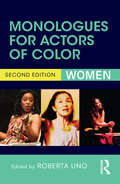- Table View
- List View
European Literary History: An Introduction
by Maarten De Pourcq Sophie LevieThis clear and engaging book offers readers an introduction to European Literary History from antiquity through to the present day. Each chapter discusses a short extract from a literary text, whilst including a close reading and a longer essay examining other key texts of the period and their place within European Literature. Offering a view of Europe as an evolving cultural space and examining the mobility and travel of literature both within and out of Europe, this guide offers an introduction to the dynamics of major literary networks, international literary networks, publication cultures and debates, and the cultural history of 'Europe' as a region as well as a concept.
European Literary History: An Introduction
by Maarten De Pourcq Sophie LevieThis clear and engaging book offers readers an introduction to European Literary History from antiquity through to the present day. Each chapter discusses a short extract from a literary text, whilst including a close reading and a longer essay examining other key texts of the period and their place within European Literature. Offering a view of Europe as an evolving cultural space and examining the mobility and travel of literature both within and out of Europe, this guide offers an introduction to the dynamics of major literary networks, international literary networks, publication cultures and debates, and the cultural history of 'Europe' as a region as well as a concept.
Vulnerability and Security in Human Rights Literature and Visual Culture (Routledge Interdisciplinary Perspectives on Literature)
by Alexandra Schultheis MooreThis book responds to the failures of human rights—the way its institutions and norms reproduce geopolitical imbalances and social exclusions—through an analysis of how literary and visual culture can make visible human rights claims that are foreclosed in official discourses. Moore draws on theories of vulnerability, precarity, and dispossession to argue for the necessity of recognizing the embodied and material contexts of human rights subjects. At the same time, she demonstrates how these theories run the risk of reproducing the structural imbalances that lie at the core of critiques of human rights. Pairing conventional human rights genres—legal instruments, human rights reports, reportage, and humanitarian campaigns—with literary and visual culture, Moore develops a transnational feminist reading praxis of five sites of rights and their violation over the past fifty years: UN human rights instruments and child soldiers in Nigerian literature; human rights reporting and novels that address state-sponsored ethnocide in Zimbabwe; the international humanitarian campaigns and disaster capitalism in fiction of Bhopal, India; the work of Médecins Sans Frontières in the Sahel, Afghanistan, Democratic Republic of Congo, and Burma as represented in various media campaigns and in photo/graphic narratives; and, finally, the human rights campaigns, fiction, and film that have brought Indonesia’s history of anti-leftist violence into contemporary public debate. These case studies underscore how human rights norms are always subject to conditions of imaginative representation, and how literature and visual culture participate in that cultural imaginary. Expanding feminist theories of embodied and imposed vulnerability, Moore demonstrates the importance of situating human rights violations not only in the context of neo-liberal development policies but also in relation to the growth of security networks that serve the nation-state often at the expense of the security of specific subjects and populations. In place of conventional victims and agents, the intersection of vulnerability and human rights opens up readings of human rights claims and suffering that are, at once, embodied and shareable, yet which run the risk of cooptation by security rhetoric.
Vulnerability and Security in Human Rights Literature and Visual Culture (Routledge Interdisciplinary Perspectives on Literature)
by Alexandra Schultheis MooreThis book responds to the failures of human rights—the way its institutions and norms reproduce geopolitical imbalances and social exclusions—through an analysis of how literary and visual culture can make visible human rights claims that are foreclosed in official discourses. Moore draws on theories of vulnerability, precarity, and dispossession to argue for the necessity of recognizing the embodied and material contexts of human rights subjects. At the same time, she demonstrates how these theories run the risk of reproducing the structural imbalances that lie at the core of critiques of human rights. Pairing conventional human rights genres—legal instruments, human rights reports, reportage, and humanitarian campaigns—with literary and visual culture, Moore develops a transnational feminist reading praxis of five sites of rights and their violation over the past fifty years: UN human rights instruments and child soldiers in Nigerian literature; human rights reporting and novels that address state-sponsored ethnocide in Zimbabwe; the international humanitarian campaigns and disaster capitalism in fiction of Bhopal, India; the work of Médecins Sans Frontières in the Sahel, Afghanistan, Democratic Republic of Congo, and Burma as represented in various media campaigns and in photo/graphic narratives; and, finally, the human rights campaigns, fiction, and film that have brought Indonesia’s history of anti-leftist violence into contemporary public debate. These case studies underscore how human rights norms are always subject to conditions of imaginative representation, and how literature and visual culture participate in that cultural imaginary. Expanding feminist theories of embodied and imposed vulnerability, Moore demonstrates the importance of situating human rights violations not only in the context of neo-liberal development policies but also in relation to the growth of security networks that serve the nation-state often at the expense of the security of specific subjects and populations. In place of conventional victims and agents, the intersection of vulnerability and human rights opens up readings of human rights claims and suffering that are, at once, embodied and shareable, yet which run the risk of cooptation by security rhetoric.
Twenty-First Century Perspectives on Indigenous Studies: Native North America in (Trans)Motion (Routledge Research in Transnational Indigenous Perspectives #1)
by Sabine N. Meyer Birgit Däwes Karsten FitzIn recent years, the interdisciplinary fields of Native North American and Indigenous Studies have reflected, at times even foreshadowed and initiated, many of the influential theoretical discussions in the humanities after the "transnational turn." Global trends of identity politics, performativity, cultural performance and ethics, comparative and revisionist historiography, ecological responsibility and education, as well as issues of social justice have shaped and been shaped by discussions in Native American and Indigenous Studies. This volume brings together distinguished perspectives on these topics by the Native scholars and writers Gerald Vizenor (Anishinaabe), Diane Glancy (Cherokee), and Tomson Highway (Cree), as well as non-Native authorities, such as Chadwick Allen, Hartmut Lutz, and Helmbrecht Breinig. Contributions look at various moments in the cultural history of Native North America—from earthmounds via the Catholic appropriation of a Mohawk saint to the debates about Makah whaling rights—as well as at a diverse spectrum of literary, performative, and visual works of art by John Ross, John Ridge, Elias Boudinot, Emily Pauline Johnson, Leslie Marmon Silko, Emma Lee Warrior, Louise Erdrich, N. Scott Momaday, Stephen Graham Jones, and Gerald Vizenor, among others. In doing so, the selected contributions identify new and recurrent methodological challenges, outline future paths for scholarly inquiry, and explore the intersections between Indigenous Studies and contemporary Literary and Cultural Studies at large.
Twenty-First Century Perspectives on Indigenous Studies: Native North America in (Trans)Motion (Routledge Research in Transnational Indigenous Perspectives)
by Sabine N. Meyer Birgit Däwes Karsten FitzIn recent years, the interdisciplinary fields of Native North American and Indigenous Studies have reflected, at times even foreshadowed and initiated, many of the influential theoretical discussions in the humanities after the "transnational turn." Global trends of identity politics, performativity, cultural performance and ethics, comparative and revisionist historiography, ecological responsibility and education, as well as issues of social justice have shaped and been shaped by discussions in Native American and Indigenous Studies. This volume brings together distinguished perspectives on these topics by the Native scholars and writers Gerald Vizenor (Anishinaabe), Diane Glancy (Cherokee), and Tomson Highway (Cree), as well as non-Native authorities, such as Chadwick Allen, Hartmut Lutz, and Helmbrecht Breinig. Contributions look at various moments in the cultural history of Native North America—from earthmounds via the Catholic appropriation of a Mohawk saint to the debates about Makah whaling rights—as well as at a diverse spectrum of literary, performative, and visual works of art by John Ross, John Ridge, Elias Boudinot, Emily Pauline Johnson, Leslie Marmon Silko, Emma Lee Warrior, Louise Erdrich, N. Scott Momaday, Stephen Graham Jones, and Gerald Vizenor, among others. In doing so, the selected contributions identify new and recurrent methodological challenges, outline future paths for scholarly inquiry, and explore the intersections between Indigenous Studies and contemporary Literary and Cultural Studies at large.
Multiracial Identity in Children's Literature: Reading Diversity In the Classroom (Routledge Research in Education #185)
by Amina ChaudhriRacially mixed children make up the fastest growing youth demographic in the U.S., and teachers of diverse populations need to be mindful in selecting literature that their students can identify with. This volume explores how books for elementary school students depict and reflect multiracial experiences through text and images. Chaudhri examines contemporary children’s literature to demonstrate the role these books play in perpetuating and resisting stereotypes and the ways in which they might influence their readers. Through critical analysis of contemporary children’s fiction, Chaudhri highlights the connections between context, literature, and personal experience to deepen our understanding of how children’s books treat multiracial identity.
Multiracial Identity in Children's Literature: Reading Diversity In the Classroom (Routledge Research in Education)
by Amina ChaudhriRacially mixed children make up the fastest growing youth demographic in the U.S., and teachers of diverse populations need to be mindful in selecting literature that their students can identify with. This volume explores how books for elementary school students depict and reflect multiracial experiences through text and images. Chaudhri examines contemporary children’s literature to demonstrate the role these books play in perpetuating and resisting stereotypes and the ways in which they might influence their readers. Through critical analysis of contemporary children’s fiction, Chaudhri highlights the connections between context, literature, and personal experience to deepen our understanding of how children’s books treat multiracial identity.
Drama and Theatre with Children: International perspectives (Routledge Research in International and Comparative Education)
by Charru SharmaDrama as a process-centred form is a popular and valued methodology used to develop thinking and learning in children, while theatre provides a greater focus on the element of performance. In recent years, offering drama and theatre as a shared experience is increasingly used to engage children and to facilitate learning in a drama classroom. Using drama and theatre as a central component with children, this book is an amalgamation of theory, research and practice from across the globe offering insights into differing educational contexts. Chapters provide an exploration of the methodologies and techniques used to improve drama in the curriculum, and highlight the beneficial impact drama has in a variety of classrooms, enriching learning and communication. Contributions from 17 authors, ranging from teachers in schools or universities, to researchers and drama practitioners, examine a variety of perspectives related to drama and children in an attempt to bridge gaps and move ahead collectively as educators, practitioners and researchers in drama and theatre. Divided into two parts, Part I reflects on the use of drama in its varied forms with children, while Part II focuses on projects and experiments with children using theatre in order to draw links between drama, theatre and pedagogy. Drama and Theatre with Children will be key reading for researchers, academics and postgraduate students in the fields of drama education, theatre education, curriculum studies and child development. The book will also be of interest to drama practitioners, school teachers and teacher training leaders.
Drama and Theatre with Children: International perspectives (Routledge Research in International and Comparative Education)
by Charru SharmaDrama as a process-centred form is a popular and valued methodology used to develop thinking and learning in children, while theatre provides a greater focus on the element of performance. In recent years, offering drama and theatre as a shared experience is increasingly used to engage children and to facilitate learning in a drama classroom. Using drama and theatre as a central component with children, this book is an amalgamation of theory, research and practice from across the globe offering insights into differing educational contexts. Chapters provide an exploration of the methodologies and techniques used to improve drama in the curriculum, and highlight the beneficial impact drama has in a variety of classrooms, enriching learning and communication. Contributions from 17 authors, ranging from teachers in schools or universities, to researchers and drama practitioners, examine a variety of perspectives related to drama and children in an attempt to bridge gaps and move ahead collectively as educators, practitioners and researchers in drama and theatre. Divided into two parts, Part I reflects on the use of drama in its varied forms with children, while Part II focuses on projects and experiments with children using theatre in order to draw links between drama, theatre and pedagogy. Drama and Theatre with Children will be key reading for researchers, academics and postgraduate students in the fields of drama education, theatre education, curriculum studies and child development. The book will also be of interest to drama practitioners, school teachers and teacher training leaders.
The Sino-Japanese War and Youth Literature: Friends and Foes on the Battlefield (Routledge Studies in Education and Society in Asia)
by Minjie ChenThe Sino-Japanese War (1937 – 1945) was fought in the Asia-Pacific theatre between Imperial Japan and China, with the United States as the latter’s major military ally. An important line of investigation remains, questioning how the history of this war has been passed on to post-war generations’ consciousness, and how information sources, particularly those exposed to young people in their formative years, shape their knowledge and bias of the conflict as well as World War II more generally. This book is the first to focus on how the Sino-Japanese War has been represented in non-English and English sources for children and young adults. As a cross-cultural study and an interdisciplinary endeavour, it not only examines youth-orientated publications in China and the United States, but also draws upon popular culture, novelists’ memoirs, and family oral narratives to make comparisons between fiction and history, Chinese and American sources, and published materials and private memories of the war. Through quantitative narrative analysis, literary and visual analysis, and socio-political critique, it shows the dominant pattern of war stories, traces chronological changes over the seven decades from 1937 to 2007, and teases out the ways in which the history of the Sino-Japanese War has been constructed, censored, and utilized to serve shifting agendas. Providing a much needed examination of public memory, literary representation, and popular imagination of the Sino-Japanese War, this book will have huge interdisciplinary appeal, particularly for students and scholars of Asian history, literature, society and education.
The Sino-Japanese War and Youth Literature: Friends and Foes on the Battlefield (Routledge Studies in Education and Society in Asia)
by Minjie ChenThe Sino-Japanese War (1937 – 1945) was fought in the Asia-Pacific theatre between Imperial Japan and China, with the United States as the latter’s major military ally. An important line of investigation remains, questioning how the history of this war has been passed on to post-war generations’ consciousness, and how information sources, particularly those exposed to young people in their formative years, shape their knowledge and bias of the conflict as well as World War II more generally. This book is the first to focus on how the Sino-Japanese War has been represented in non-English and English sources for children and young adults. As a cross-cultural study and an interdisciplinary endeavour, it not only examines youth-orientated publications in China and the United States, but also draws upon popular culture, novelists’ memoirs, and family oral narratives to make comparisons between fiction and history, Chinese and American sources, and published materials and private memories of the war. Through quantitative narrative analysis, literary and visual analysis, and socio-political critique, it shows the dominant pattern of war stories, traces chronological changes over the seven decades from 1937 to 2007, and teases out the ways in which the history of the Sino-Japanese War has been constructed, censored, and utilized to serve shifting agendas. Providing a much needed examination of public memory, literary representation, and popular imagination of the Sino-Japanese War, this book will have huge interdisciplinary appeal, particularly for students and scholars of Asian history, literature, society and education.
The Sublime (The New Critical Idiom)
by Philip ShawRelated to ideas of the great, the awe-inspiring and the overpowering, the sublime has been debated for centuries amongst writers, artists, philosophers and theorists and has become a complex yet crucial concept in many disciplines. In this thoroughly updated edition, Philip Shaw looks at: Early modern and post-Romantic conceptions of the sublime in two brand new chapters The legacy of the earliest classical theories, through those of the long eighteenth century to modernist, postmodernist and avant-garde conceptions of the sublime Critical Introductions to major theorists of the sublime such as Longinus, Burke, Kant, Schopenhauer, Nietzsche, Derrida, Lyotard, Lacan and Žižek The significance of the concept through a range of literary readings, including the Old and New Testaments, Homer, Milton and writing from the Romantic period to the present day How the concept of the sublime has affected other art forms such as painting and film, from abstract expressionism to David Lynch’s neo-noir The influence of the sublime on recent debates in the fields of politics, theology and psychoanalysis. Offering historical overviews and explanations, this remarkably clear study is essential reading for students of literature, critical and cultural theory.
The Sublime (The New Critical Idiom)
by Philip ShawRelated to ideas of the great, the awe-inspiring and the overpowering, the sublime has been debated for centuries amongst writers, artists, philosophers and theorists and has become a complex yet crucial concept in many disciplines. In this thoroughly updated edition, Philip Shaw looks at: Early modern and post-Romantic conceptions of the sublime in two brand new chapters The legacy of the earliest classical theories, through those of the long eighteenth century to modernist, postmodernist and avant-garde conceptions of the sublime Critical Introductions to major theorists of the sublime such as Longinus, Burke, Kant, Schopenhauer, Nietzsche, Derrida, Lyotard, Lacan and Žižek The significance of the concept through a range of literary readings, including the Old and New Testaments, Homer, Milton and writing from the Romantic period to the present day How the concept of the sublime has affected other art forms such as painting and film, from abstract expressionism to David Lynch’s neo-noir The influence of the sublime on recent debates in the fields of politics, theology and psychoanalysis. Offering historical overviews and explanations, this remarkably clear study is essential reading for students of literature, critical and cultural theory.
Skepticism and Belonging in Shakespeare's Comedy (Routledge Studies in Shakespeare)
by Derek GottliebThis book recovers a sense of the high stakes of Shakespearean comedy, arguing that the comedies, no less than the tragedies, serve to dramatize responses to the condition of being human, responses that invite scholarly investigation and explanation. Taking its cue from Stanley Cavell’s influential readings of Othello and Lear, the book argues that exposure or vulnerability to others is the source of both human happiness and human misery; while the tragedies showcase attempts at the evasion of such vulnerability through the self-defeating pursuit of epistemological certainty, the comedies present the drama and the difficulty of turning away from an epistemological register in order to productively respond to the fact of our humanity. Where Shakespeare’s tragedies might be viewed in Cavellian terms as the drama of skepticism, Shakespeare’s comedies then exemplify the drama of acknowledgement. As a parallel and a preamble, Gottlieb suggests that the field of literary studies is itself a site of such revealing responses: where competing research methods strive to foreclose upon (or, alternatively, rejoice in) epistemological uncertainty, such commitments bespeak an urge to avoid or circumvent the human in the practice of scholarship. Reading Shakespeare’s comedies in tandem with a "defactoist" view of teaching and learning points in the direction of a new humanism, one that eschews both the relativism of old deconstruction and contemporary Presentism and the determinism of various kinds of structural accounts. This book offers something new in scholarly and popular understanding of Shakespeare’s work, doing so with both philosophical rigor and literary attention to the difficult work of reading.
Skepticism and Belonging in Shakespeare's Comedy (Routledge Studies in Shakespeare)
by Derek GottliebThis book recovers a sense of the high stakes of Shakespearean comedy, arguing that the comedies, no less than the tragedies, serve to dramatize responses to the condition of being human, responses that invite scholarly investigation and explanation. Taking its cue from Stanley Cavell’s influential readings of Othello and Lear, the book argues that exposure or vulnerability to others is the source of both human happiness and human misery; while the tragedies showcase attempts at the evasion of such vulnerability through the self-defeating pursuit of epistemological certainty, the comedies present the drama and the difficulty of turning away from an epistemological register in order to productively respond to the fact of our humanity. Where Shakespeare’s tragedies might be viewed in Cavellian terms as the drama of skepticism, Shakespeare’s comedies then exemplify the drama of acknowledgement. As a parallel and a preamble, Gottlieb suggests that the field of literary studies is itself a site of such revealing responses: where competing research methods strive to foreclose upon (or, alternatively, rejoice in) epistemological uncertainty, such commitments bespeak an urge to avoid or circumvent the human in the practice of scholarship. Reading Shakespeare’s comedies in tandem with a "defactoist" view of teaching and learning points in the direction of a new humanism, one that eschews both the relativism of old deconstruction and contemporary Presentism and the determinism of various kinds of structural accounts. This book offers something new in scholarly and popular understanding of Shakespeare’s work, doing so with both philosophical rigor and literary attention to the difficult work of reading.
Steampunk and Nineteenth-Century Digital Humanities: Literary Retrofuturisms, Media Archaeologies, Alternate Histories (Routledge Interdisciplinary Perspectives on Literature)
by Roger WhitsonSteampunk is more than a fandom, a literary genre, or an aesthetic. It is a research methodology turning history inside out to search for alternatives to the progressive technological boosterism sold to us by Silicon Valley. This book turns to steampunk's quirky temporalities to embrace diverse genealogies of the digital humanities and to unite their methodologies with nineteenth-century literature and media archaeology. The result is nineteenth-century digital humanities, a retrofuturist approach in which readings of steampunk novels like William Gibson and Bruce Sterling's The Difference Engine and Ken Liu's The Grace of Kings collide with nineteenth-century technological histories like Charles Babbage's use of the difference engine to enhance worker productivity and Isabella Bird's spirit photography of alternate history China. Along the way, Steampunk and Nineteenth-Century Digital Humanities considers steampunk as a public form of digital humanities scholarship and activism, examining projects like Kinetic Steam Works's reconstruction of Henri Giffard's 1852 steam-powered airship, Jake von Slatt's use of James Wimshurst's 1880 designs to create an electric influence machine, and the queer steampunk activism of fans appearing at conventions around the globe. Steampunk as a digital humanities practice of repurposing reacts to the growing sense of multiple non-human temporalities mediating our human histories: microtemporal electricities flowing through our computer circuits, mechanical oscillations marking our work days, geological stratifications and cosmic drifts extending time into the millions and billions of years. Excavating the entangled, anachronistic layers of steampunk practice from video games like Bioshock Infinite to marine trash floating off the shore of Los Angeles and repurposed by media artist Claudio Garzón into steampunk submarines, Steampunk and Nineteenth-Century Digital Humanities uncovers the various technological temporalities and multicultural retrofutures illuminating many alternate histories of the digital humanities.
Steampunk and Nineteenth-Century Digital Humanities: Literary Retrofuturisms, Media Archaeologies, Alternate Histories (Routledge Interdisciplinary Perspectives on Literature)
by Roger WhitsonSteampunk is more than a fandom, a literary genre, or an aesthetic. It is a research methodology turning history inside out to search for alternatives to the progressive technological boosterism sold to us by Silicon Valley. This book turns to steampunk's quirky temporalities to embrace diverse genealogies of the digital humanities and to unite their methodologies with nineteenth-century literature and media archaeology. The result is nineteenth-century digital humanities, a retrofuturist approach in which readings of steampunk novels like William Gibson and Bruce Sterling's The Difference Engine and Ken Liu's The Grace of Kings collide with nineteenth-century technological histories like Charles Babbage's use of the difference engine to enhance worker productivity and Isabella Bird's spirit photography of alternate history China. Along the way, Steampunk and Nineteenth-Century Digital Humanities considers steampunk as a public form of digital humanities scholarship and activism, examining projects like Kinetic Steam Works's reconstruction of Henri Giffard's 1852 steam-powered airship, Jake von Slatt's use of James Wimshurst's 1880 designs to create an electric influence machine, and the queer steampunk activism of fans appearing at conventions around the globe. Steampunk as a digital humanities practice of repurposing reacts to the growing sense of multiple non-human temporalities mediating our human histories: microtemporal electricities flowing through our computer circuits, mechanical oscillations marking our work days, geological stratifications and cosmic drifts extending time into the millions and billions of years. Excavating the entangled, anachronistic layers of steampunk practice from video games like Bioshock Infinite to marine trash floating off the shore of Los Angeles and repurposed by media artist Claudio Garzón into steampunk submarines, Steampunk and Nineteenth-Century Digital Humanities uncovers the various technological temporalities and multicultural retrofutures illuminating many alternate histories of the digital humanities.
Essays on Fiction 1971-82 (Routledge Revivals)
by Sir Frank KermodeIn this book, which was first published in 1983, Frank Kermode looks in particular at the revived Russian Formalism, a highly original body of literary theory that flourished in the years immediately following the Revolution, and at the work of Roman Jakobson, one of its most distinguished exponents. He discusses its modern ‘structuralist’ descendants, recalling the importance of Roland Barthes and the invigorating effect of his fertile and surprising mind. He considers also the work of Foucault, Laca and Levi-Strauss, as well as that of Jacques Derrida, which uses a novel and de(con)structive method of analysis to question to tacit assumptions on which structuralism is based. In an opening chapter, Professor Kermode surveys his relationship with the new theory, explaining that it is a relation from which he has benefited without ever feeling disposed to join a movement. These essays will be of interest to students of literature.
Essays on Fiction 1971-82 (Routledge Revivals)
by Sir Frank KermodeIn this book, which was first published in 1983, Frank Kermode looks in particular at the revived Russian Formalism, a highly original body of literary theory that flourished in the years immediately following the Revolution, and at the work of Roman Jakobson, one of its most distinguished exponents. He discusses its modern ‘structuralist’ descendants, recalling the importance of Roland Barthes and the invigorating effect of his fertile and surprising mind. He considers also the work of Foucault, Laca and Levi-Strauss, as well as that of Jacques Derrida, which uses a novel and de(con)structive method of analysis to question to tacit assumptions on which structuralism is based. In an opening chapter, Professor Kermode surveys his relationship with the new theory, explaining that it is a relation from which he has benefited without ever feeling disposed to join a movement. These essays will be of interest to students of literature.
The Muse: Psychoanalytic Explorations of Creative Inspiration (Psychoanalytic Inquiry Book Series)
by Adele TutterPsychoanalysts have long been fascinated with creative artists, but have paid far less attention to the men and women who motivate, stimulate, and captivate them. The Muse counters this trend with nine original contributions from distinguished psychoanalysts, art historians, and literary scholars—one for each of the nine muses of classical mythology—that explore the muses of disparate artists, from Nicholas Poussin to Alison Bechdel. The Muse breaks new ground, pushing the traditional conceptualization of muses by considering the roles of spouse, friend, rival, patron, therapist—even a late psychoanalytic theorist—in facilitating creativity. Moreover, they do so not only by providing inspiration, but also by offering the artist needed material and emotional support; tolerating competitive aggression; promoting reflection and insight; and eliciting awe, anxiety and gratitude. Integrating art history and literary criticism with a wide spectrum of contemporary psychoanalytic perspectives, The Muse is essential reading for psychoanalysts and psychotherapists interested in the relationships that enhance and support creative work. Fully interdisciplinary, it is also accessible to readers in the fields of art, art history, literature, memoir, and film. The Muse sheds new light on that most mysterious dyad, the artist and muse—and thus on the creative process itself.
The Muse: Psychoanalytic Explorations of Creative Inspiration (Psychoanalytic Inquiry Book Series)
by Adele TutterPsychoanalysts have long been fascinated with creative artists, but have paid far less attention to the men and women who motivate, stimulate, and captivate them. The Muse counters this trend with nine original contributions from distinguished psychoanalysts, art historians, and literary scholars—one for each of the nine muses of classical mythology—that explore the muses of disparate artists, from Nicholas Poussin to Alison Bechdel. The Muse breaks new ground, pushing the traditional conceptualization of muses by considering the roles of spouse, friend, rival, patron, therapist—even a late psychoanalytic theorist—in facilitating creativity. Moreover, they do so not only by providing inspiration, but also by offering the artist needed material and emotional support; tolerating competitive aggression; promoting reflection and insight; and eliciting awe, anxiety and gratitude. Integrating art history and literary criticism with a wide spectrum of contemporary psychoanalytic perspectives, The Muse is essential reading for psychoanalysts and psychotherapists interested in the relationships that enhance and support creative work. Fully interdisciplinary, it is also accessible to readers in the fields of art, art history, literature, memoir, and film. The Muse sheds new light on that most mysterious dyad, the artist and muse—and thus on the creative process itself.
Ageing, Gender, and Illness in Anglophone Literature: Narrating Age in the Bildungsroman (Routledge Interdisciplinary Perspectives on Literature)
by Heike HartungThis study establishes age as a category of literary history, delineating age in its interaction with gender and narrative genre. Based on the historical premise that the view of ageing as a burden emerges as a specific narrative in the late eighteenth century, the study highlights how the changing experience of ageing is shaped by that of gender. By reading the Bildungsroman as a 'coming of age' novel, the book asks how the telling of a life in time affects individual age narratives. Bringing together the different perspectives of age and disability studies, the book argues that illness is already an important issue in the Bildungsroman's narratives of ageing. This theoretical stance provides new interpretations of canonical novels, visiting authors such as Johann Wolfgang Goethe, Frances Burney, Maria Edgeworth, Jane Austen, Charles Dickens, George Eliot, Samuel Beckett, and Jonathan Franzen. Drawing on the link between age and illness in the Bildungsroman's age narratives, the genre of 'dementia narrative' is presented as one of the directions which the Bildungsroman takes after its classical period. Applying these theoretical perspectives to canonical novels of the nineteenth century and to the new genre of 'dementia narrative', the volume also provides new insights into literary and genre history. This book introduces a new theoretical approach to cultural age studies and offers a comprehensive analysis of the connection between narratology, literary theory, gender and age studies.
Ageing, Gender, and Illness in Anglophone Literature: Narrating Age in the Bildungsroman (Routledge Interdisciplinary Perspectives on Literature)
by Heike HartungThis study establishes age as a category of literary history, delineating age in its interaction with gender and narrative genre. Based on the historical premise that the view of ageing as a burden emerges as a specific narrative in the late eighteenth century, the study highlights how the changing experience of ageing is shaped by that of gender. By reading the Bildungsroman as a 'coming of age' novel, the book asks how the telling of a life in time affects individual age narratives. Bringing together the different perspectives of age and disability studies, the book argues that illness is already an important issue in the Bildungsroman's narratives of ageing. This theoretical stance provides new interpretations of canonical novels, visiting authors such as Johann Wolfgang Goethe, Frances Burney, Maria Edgeworth, Jane Austen, Charles Dickens, George Eliot, Samuel Beckett, and Jonathan Franzen. Drawing on the link between age and illness in the Bildungsroman's age narratives, the genre of 'dementia narrative' is presented as one of the directions which the Bildungsroman takes after its classical period. Applying these theoretical perspectives to canonical novels of the nineteenth century and to the new genre of 'dementia narrative', the volume also provides new insights into literary and genre history. This book introduces a new theoretical approach to cultural age studies and offers a comprehensive analysis of the connection between narratology, literary theory, gender and age studies.
Monologues for Actors of Color: Women
by Roberta Uno Margaret OdetteActors of colour need the best speeches to demonstrate their skills and hone their craft. Roberta Uno has carefully selected monologues that represent African-American, Native American, Latino, and Asian-American identities. Each monologue comes with an introduction and notes on the characters and stage directions to set the scene for the actor. This new edition now includes more of the most exciting and accomplished playwrights to have emerged over the 15 years since the Monologues for Actors of Color books were first published, from new, cutting edge talent to Pulitzer winners.
